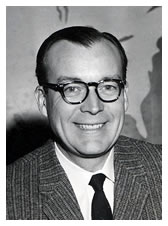
Doug Mayes, WBTV's First Newscaster


Doug Mayes, WBTV's First Newscaster
There probably was never a group photo taken that included all the members of the television news department. At any given time there were always some who were off duty, on assignment or on vacation. In the mid 1970s, when most of these photos were taken, there were from 40 to 60 men and women in the department, counting photolab personnel, engineers and graphic artists. (In the 1981 station phone directory, there are 50 names assigned to the TV news and sports departments.)
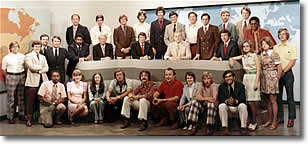 |
| Some of the TV News Team - 1970s |
To the casual viewer, unaware of all that happens behind the scenes, it might have appeared that Doug Mayes, Jim Thacker and Clyde McLean (news, sports and weather, respectively) and their successors did it all. Au contraire. It took—and still takes—a village, and a pretty big one at that, to collect, write, photograph, process, edit and produce all the news that flows out over WBTV's airwaves.
WBTV's newsroom was an incubator for many who would move on to the networks and large markets. Just a few of those who honed their craft at WBTV were: Nelson Benton, Kathy Moore and Bill Whitaker (to CBS News); Don Robertson (CBS Sports); Robert Hager and Ken Alvord (NBC News); Al Dale (ABC News); Gail Harris (WBZ, WBGH-TV, Boston); Lori Stokes (MSNBC, then WABC-TV, New York); and Rita Cosby (for a while at MSNBC).
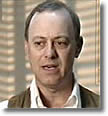 A name that appeared not long ago in national obituary columns was that of Mike Piller, who early in his career served a stint at WBTV News. He left and became a Hollywood writer and producer, working first on such shows as Simon & Simon, Cagney & Lacy and Miami Vice.
A name that appeared not long ago in national obituary columns was that of Mike Piller, who early in his career served a stint at WBTV News. He left and became a Hollywood writer and producer, working first on such shows as Simon & Simon, Cagney & Lacy and Miami Vice.
In the 1990s Mike Piller became the guiding force behind the Star Trek TV franchise: Deep Space Nine, The Next Generation and Voyager. More recently he was executive producer of Stephen's King's The Dead Zone series. Sadly, Mike died in 2005 at age 57.
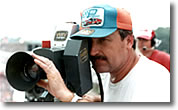 One of the many talented news photographers of those days, Charles "Chuck" Hemrick, loaned us his collection of photos of news personnel and activities. We'll build on them with images from other sources.
One of the many talented news photographers of those days, Charles "Chuck" Hemrick, loaned us his collection of photos of news personnel and activities. We'll build on them with images from other sources.
If you have pictures and information that beg to be added to this collection, don't hesitate to send them in.
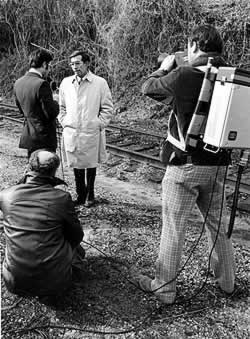 |
You went wherever the news took you, into the poison oak and kudzu—into the nasty, smelly places where news so often happens. That's Mike Cozza interviewing someone with the help of engineer Bob Lawing and cameraman Chuck Hemrick. |
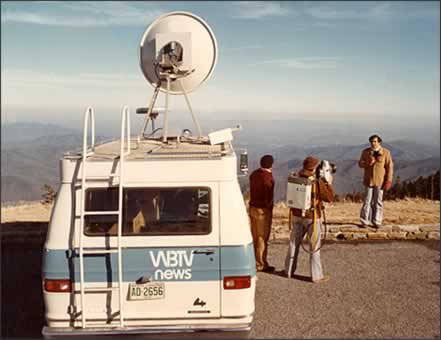 |
|
| On the other hand, it could take you to places of breathtaking beauty like here in the Blue Ridge Mountains. Andrew Schorr is reporting and Chuck is "doin' the shootin'." The round dish atop the truck was beaming the signal directly to a similar receiving dish 90-or-so miles away (as the microwave signal flies) at WBTV's studios in Charlotte. There it would either be presented live, or taped for inclusion in the next newscast. | |
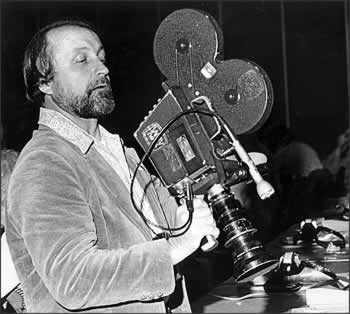 In olden days all the news gathered out in the field was captured on 16mm sound-on film. The photographer would rush back to the studio so that it could be processed (developed) and edited into a story. Here Chuck Hemrick wrestles an unweildy Auricon camera at election headquarters in downtown Charlotte in Nov. '77. Before computers, election night required a huge effort, when staffers from all departments were enlisted to help get the returns back to the station by very primative means. At election headquarters the data was written on huge chalkboards and we had to retrieve and forward that information as best we could.
In olden days all the news gathered out in the field was captured on 16mm sound-on film. The photographer would rush back to the studio so that it could be processed (developed) and edited into a story. Here Chuck Hemrick wrestles an unweildy Auricon camera at election headquarters in downtown Charlotte in Nov. '77. Before computers, election night required a huge effort, when staffers from all departments were enlisted to help get the returns back to the station by very primative means. At election headquarters the data was written on huge chalkboards and we had to retrieve and forward that information as best we could.
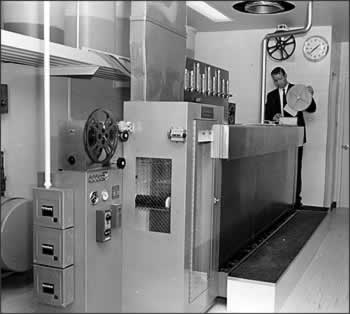 Back at the ranch, the exposed film was delivered to the lab, where all the rolls would be combined onto a master reel and fed into this processing unit. When it came out the other end (in about 20 minutes) the footage would be restored to the original increments, and rushed to the newsroom for editing. For several years Ron Harrington was in charge of the lab. He's shown here feeding a new batch into the system. There is a considerable amount of silver in the emulsion of film. Ron received recognition for devising a method for recovering a large portion of the silver that would wash off during the developing process.
Back at the ranch, the exposed film was delivered to the lab, where all the rolls would be combined onto a master reel and fed into this processing unit. When it came out the other end (in about 20 minutes) the footage would be restored to the original increments, and rushed to the newsroom for editing. For several years Ron Harrington was in charge of the lab. He's shown here feeding a new batch into the system. There is a considerable amount of silver in the emulsion of film. Ron received recognition for devising a method for recovering a large portion of the silver that would wash off during the developing process.
Full disclosure: This is a staged photo made for promotional purposes in Sept. '72. The "interviewee" is actually Mike Piller, another reporter. Chuck Hemrick is camera man. |
|
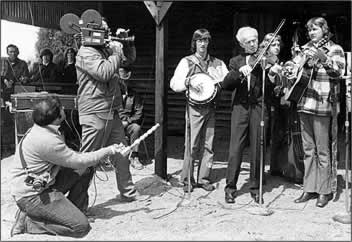 The Union Grove Fiddler's Convention in Iredell County, N. C. has been a huge event for bluegrass lovers since 1924. Here, in the early '70s, Andrew Schorr (with mic) and Chuck Hemrick are filming a segment to appear on the 6:00 o'clock news. Chuck was right at home in the foothills and mountains of North Carolina. He was part of the Carolina Camera unit for a few years, traveling all over the viewing area, and from 1980 to 1983 was attached to the Western Bureau, working out of Morganton with reporter Steve Onesorge.
The Union Grove Fiddler's Convention in Iredell County, N. C. has been a huge event for bluegrass lovers since 1924. Here, in the early '70s, Andrew Schorr (with mic) and Chuck Hemrick are filming a segment to appear on the 6:00 o'clock news. Chuck was right at home in the foothills and mountains of North Carolina. He was part of the Carolina Camera unit for a few years, traveling all over the viewing area, and from 1980 to 1983 was attached to the Western Bureau, working out of Morganton with reporter Steve Onesorge.
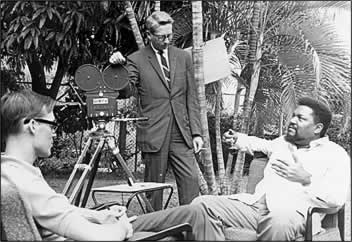 In the early '60s Robert F. Williams, from Monroe, N.C., an advocate of revolutionary violence on behalf of Black Americans, and wanted by the FBI, had fled to Cuba. A WBTV news team flew to Cuba to interview Williams for a documentary. That's newsman Ken Alvord at left, Clyde McClean, and Williams at right. Erv Melton was probably the cameraman, Ken was the producer/reporter and Clyde the interviewer. (In 1969 the charges against Williams were dropped and he was allowed to return to this country.)
In the early '60s Robert F. Williams, from Monroe, N.C., an advocate of revolutionary violence on behalf of Black Americans, and wanted by the FBI, had fled to Cuba. A WBTV news team flew to Cuba to interview Williams for a documentary. That's newsman Ken Alvord at left, Clyde McClean, and Williams at right. Erv Melton was probably the cameraman, Ken was the producer/reporter and Clyde the interviewer. (In 1969 the charges against Williams were dropped and he was allowed to return to this country.)
|
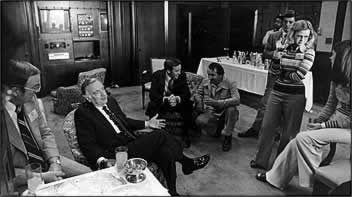 Inevitably someone would corner Uncle Walter and elicit his thoughts on the current state of journalism or some other weighty topic. The other attendees would politely edge away and talk among themselves about more immediate concerns. That's Doug Mayes at left, Bruce Bowers and Chuck Hemrick in the center, and Gail Harris and Cathy Moore at right. Behind Gail is John Wilson. Photos courtesy Chuck Hemrick |
|
Photos courtesy Chuck Hemrick |
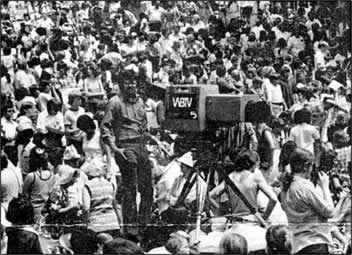 On May 20, 1975President Ford came to town and made a speech in Freedom Park. Hardly a year into his presidency, he no doubt came to reassure us about the state of the nation and the world. Thousands turned out and the BT stations pulled out all the stops, hauled out the big iron. Never mind the cost; it was our responsibility. That appears to be Tom Landen on camera.
On May 20, 1975President Ford came to town and made a speech in Freedom Park. Hardly a year into his presidency, he no doubt came to reassure us about the state of the nation and the world. Thousands turned out and the BT stations pulled out all the stops, hauled out the big iron. Never mind the cost; it was our responsibility. That appears to be Tom Landen on camera.
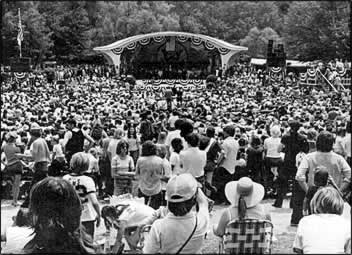 Somewhere in this multitude every available person from the news, engineering and program departments was positioned to cover all aspects of the big event. Management was deeply committed to public affairs programming. In fact, in those days, broadcast stations were mandated by law (as well as tradition) to serve the public interest. Imagine that.
Somewhere in this multitude every available person from the news, engineering and program departments was positioned to cover all aspects of the big event. Management was deeply committed to public affairs programming. In fact, in those days, broadcast stations were mandated by law (as well as tradition) to serve the public interest. Imagine that.
Photos courtesy Chuck Hemrick
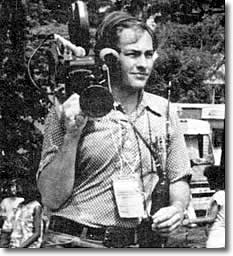 |
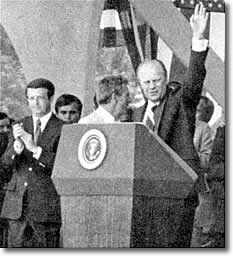 |
| Sometimes he shot film for news and at other times for Creative Services (and still does). Wherever
he showed up, John Steed arrived with his immense talent and unflagging dedication to the company and his job.
If WBTV had a Mr. Nice Guy Award, John would win it hands down. |
With North Carolina's Governor James Holshouser alongside, President Ford concludes his speech and gives a final wave to the crowd. Time to start packing the gear and rush back to the newsroom's editing bays to prepare a series of stories for the evening news. |
Photos courtesy Chuck Hemrick |
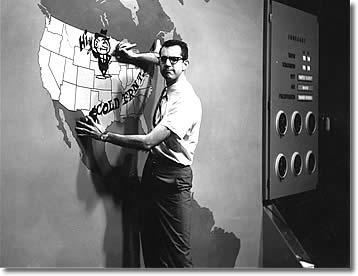 It takes all kinds of preparation to get a newscast on the air. For a time in the '60s, for each day's noon weathercast, artist Jim Scancarelli would spend an hour "adorning" Clyde McLean's weather map with clever, topical illustrations, some pertaining to the weather, some not. Anything to draw a crowd (of viewers). It takes all kinds of preparation to get a newscast on the air. For a time in the '60s, for each day's noon weathercast, artist Jim Scancarelli would spend an hour "adorning" Clyde McLean's weather map with clever, topical illustrations, some pertaining to the weather, some not. Anything to draw a crowd (of viewers). |
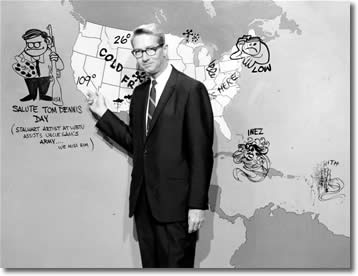 Then Clyde would show up to see what Jim had wrought. On this day, attention was called to a low pressure area over New England, Hurricane Inez in the vicinity of Cuba, and the fact that Jim's fellow artist at WBTV, Tom Dennis, was leaving for the army—and likely Vietnam. It was late September 1966. Then Clyde would show up to see what Jim had wrought. On this day, attention was called to a low pressure area over New England, Hurricane Inez in the vicinity of Cuba, and the fact that Jim's fellow artist at WBTV, Tom Dennis, was leaving for the army—and likely Vietnam. It was late September 1966. |
Photos courtesy Jim Scancarelli |
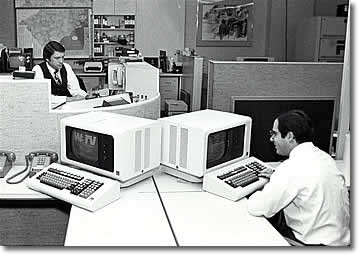 By the early '80s the news room had become hi-tech. Reporters and editors could now write and edit their stories and assemble the newscasts on computers. Cutting and pasting assumed a whole new meaning, no longer involving scissors and rubber cement. Anchorman Bob Inman is busy in the background. Mike Cozza, for eight years the company's Washington correspondent, is scrolling through a list of news stories stored in the computer. Look, Ma, no paper! By the early '80s the news room had become hi-tech. Reporters and editors could now write and edit their stories and assemble the newscasts on computers. Cutting and pasting assumed a whole new meaning, no longer involving scissors and rubber cement. Anchorman Bob Inman is busy in the background. Mike Cozza, for eight years the company's Washington correspondent, is scrolling through a list of news stories stored in the computer. Look, Ma, no paper! |
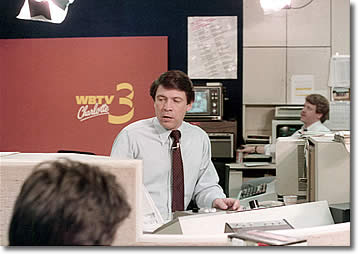 Then came the day when cameras were so small and inexpensive that one could be mounted permanently in the news room, so that reporters could quickly get on the air with bulletins or scheduled news breaks. That's Bob Inman, about to "go live." To the right, out of camera range is producer Graham Wilson. When the segment ended, someone would switch off the bright TV lights, and the normal hum of activity in the news room would resume. Then came the day when cameras were so small and inexpensive that one could be mounted permanently in the news room, so that reporters could quickly get on the air with bulletins or scheduled news breaks. That's Bob Inman, about to "go live." To the right, out of camera range is producer Graham Wilson. When the segment ended, someone would switch off the bright TV lights, and the normal hum of activity in the news room would resume. |
For a little insight into those "golden" days, read these recollections of Bob Inman and Mike Cozza. Photos courtesy Bob Inman |
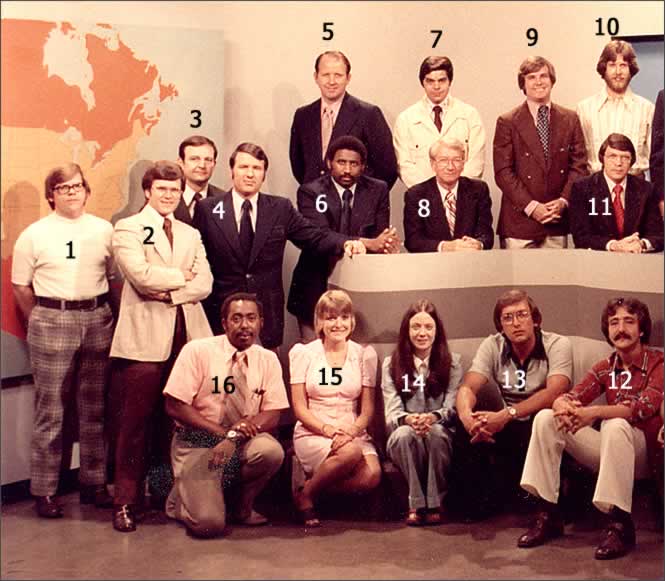
This is the left half of a photo of many of the news staff sometime in the 1970s. The right half of the photo is on the following page.
Front row, from left: Jan Spence, Photographer; Cindy Cubley, News Assistant; Kathy Moore, Reporter; Eddie Hollifield, Photographer; John Baynard, Photographer.
At desk: Ken Koontz, Reporter; Clyde McLean, Weatherman; Bob Inman, Anchorman.
Standing: Ken Beaver, Director; Rod Gragg, Reporter; Bill Ballard, News Director; John Stone, Reporter; Ron Harrington, Operations Manager; Ron Depaulis, Reporter; Bob Schellenberg, Sports Reporter; Brad Stafford, Photographer.
Photo courtesy Chuck Hemrick
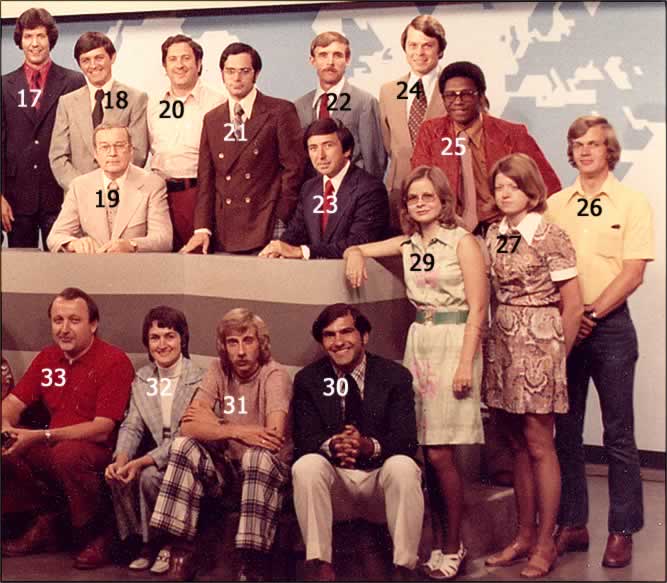
This is the right half of a photo of many of the news staff sometime in the 1970s. The left half of the photo is on the previous page.
Front row, seated: Chuck Hemrick, Photographer; B. J. Caldwell, News Secretary; David Little, Photographer; Andrew Schorr, Reporter.
At desk, from left: Doug Mayes, Anchorman; Jim Thacker, Sports Director.
Standing, clockwise from left: Mike McKay, Weatherman; John Wilson, Anchorman; C. J. Underwood, Carolina Camera Reporter; Mike Cozza, Reporter; Rich Mortenson, Assignment Editor; Bob Taylor, Sports Reporter; Unidentified intern; Terry Lorch, Photographer; Tina Young, News Assistant; Gail Harris, Reporter.
Photo courtesy Chuck Hemrick